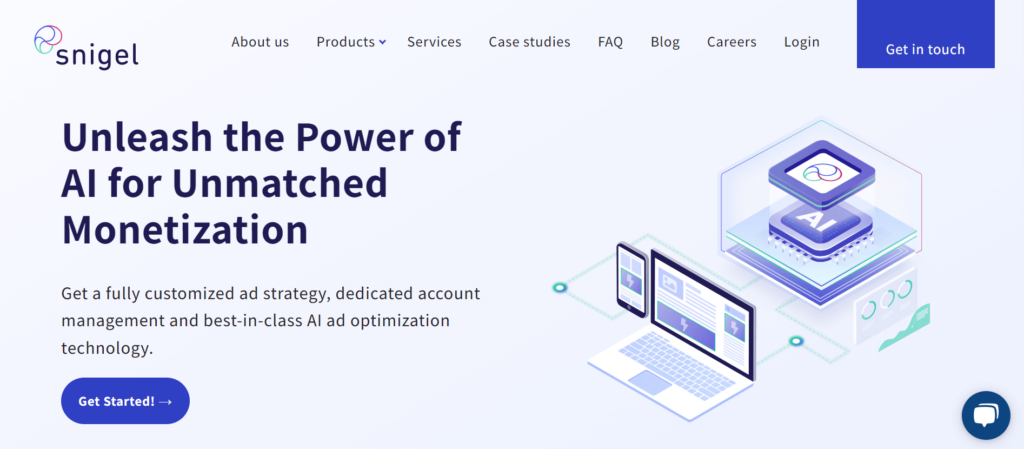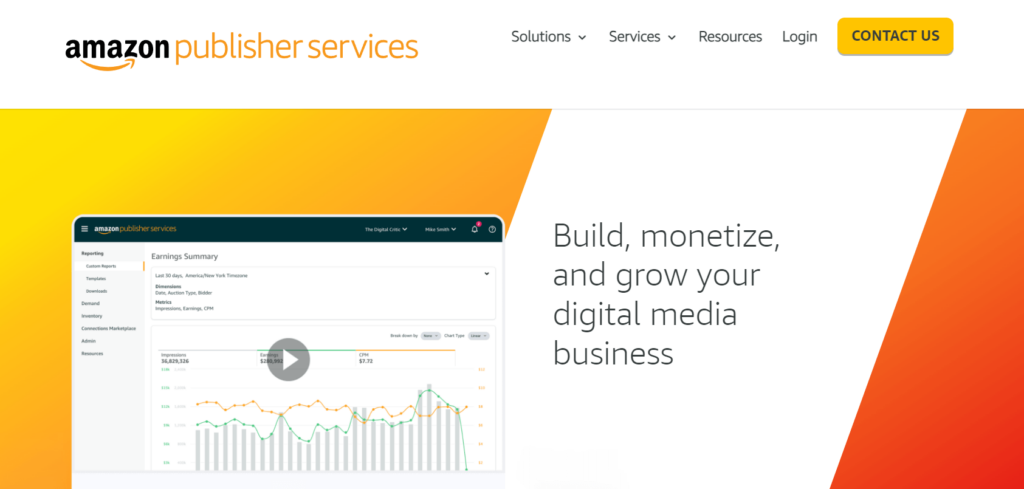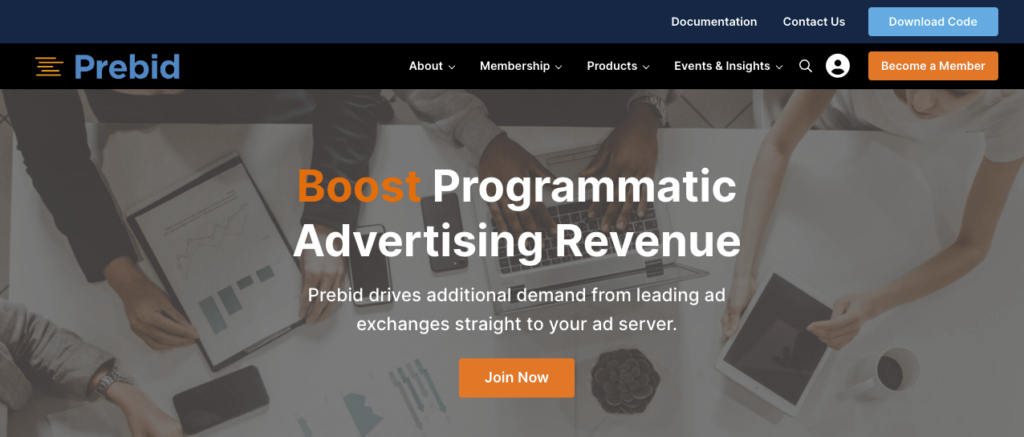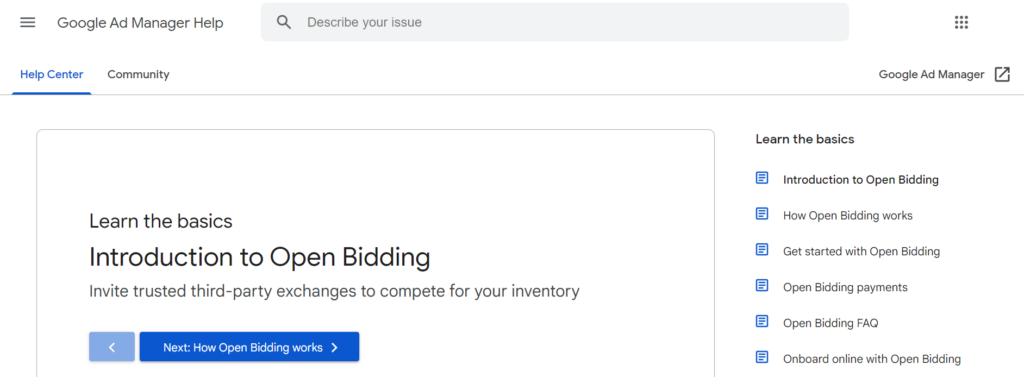Header bidding solutions let publishers take advantage of multiple demand sources (i.e., SSPs, ad exchanges, and ad networks) when selling their ad inventory. This increases the publisher’s revenue because the advertising demand sources bid against each other as they try to win ad impressions, which drives up the price.
Just making the switch from selling ad inventory via one demand source to using header bidding can increase ad revenue by up to 65%.
However, the solution you choose will greatly impact how successful you are with header bidding. For example, some solutions provide a cookie-cutter setup for websites, while others customize the ad stack to fit the unique needs of your website. In our 10+ years of experience helping publishers get the most out of their ad inventory, we’ve found that building a customized ad strategy is the key to an effective ad monetization strategy.
In this guide, we briefly cover what header bidding is and how it works. Then, we cover 5 factors to consider when choosing the best header bidding solution for your website. Finally, we compare five options, starting with an in-depth look at our header bidding solution, Snigel AdEngine.
Snigel provides advanced AI-powered ad tech to help you maximize ad revenue without compromising the user experience. Plus, you get a dedicated ad management expert who will create, implement, and manage a highly customized ad strategy for you. Get in touch for a free assessment.
What Header Bidding Is and Why It’s Beneficial for Publishers
Header bidding (also called pre-bidding) lets publishers offer their ad inventory to multiple demand sources simultaneously in real-time (i.e., an ad auction), which increases the cost-per-mille (CPM).
![How Header Bidding Works [Illustration]](https://static.snigel.com/uploads/2023/08/how-header-bidding-works.png)
If a publisher is only selling their ad inventory to one demand partner at a time, there’s less competition for the ad space, which often results in less revenue for the publisher. By offering ad inventory to multiple demand sources, publishers are able to reach more advertisers. This increases competition, which means advertisers have to pay more to outbid each other and win impressions.
You can test this out for yourself using our AdSense revenue calculator. This calculator lets you compare potential ad revenue with AdSense (a solution for selling ad inventory to just the advertisers using Google’s demand platform) vs. Snigel (our header bidding stack).
On average, publishers see an increase in ad revenue of 57% when switching from AdSense to Snigel.
How Header Bidding Technology Works

In order to use header bidding, publishers install a snippet of Javascript code (called a header bidding wrapper) in the header of their website. Each time a user visits a page, the header bidding wrapper triggers the header bidding process. In the milliseconds before the page loads, the ad auction takes place, the winning bid is determined, and the ad creative is displayed for the user.
The header bidding wrapper also lets publishers set rules for profitable real-time bidding (RTB) — such as how long advertisers have to place their bid — and easily add or remove demand sources without altering the website’s code.
Header bidding solutions give publishers access to a header bidding wrapper and a platform from which they can manage the header bidding process. Some header bidding solutions also provide additional ad tech and services to help maximize ad revenue.
To learn more, you can read our comprehensive header bidding guide for publishers.
Factors to Consider When Choosing a Header Bidding Solution
The header bidding solution you choose impacts the amount of ad revenue you’re able to earn and how much control you have over your ad strategy and setup.
Here are six factors to consider to help you find the best fit for your website:
1. Open-Source Platforms vs. Header Bidding Partners
There are two overarching categories of header bidding solutions: open-source platforms and header bidding partners.
Open-source header bidding platforms are free to use, but you’ll be responsible for everything from inserting and maintaining the header bidding wrapper to creating accounts with demand sources to deciding the optimal placement of ads on your website. Plus, if you want any additional ad tech (see the next factor to consider for more details), you’ll have to build it yourself or connect a third-party solution. Typically, only large enterprises have the resources to effectively manage all of this in house. You would need a developer and an ad operations expert (or team) to get the most from this setup.
Header bidding partners not only provide a header bidding wrapper for you to use, but they also connect to demand sources for you. Plus, they’ve typically already built additional ad tech on top of the header bidding wrapper so that you don’t have to.
2. Additional Ad Tech
Header bidding wrappers simply enable you to begin using header bidding, but to get the most out of it, you need more ad tech.
For example, using a sticky sidebar (where the ad stays in view even as the user scrolls down the content) increases the amount of time the ad is visible to the user, which makes it more valuable to advertisers. Typically, advertisers are willing to pay more for ad spots in a sticky sidebar. However, that requires ad tech beyond just the header bidding wrapper.
Like we mentioned under the previous consideration, header bidding partners typically offer additional ad tech, while open-source platforms don’t. However, not all header bidding partners have developed the same ad tech, so you’ll want to carefully compare what each one has to offer.
3. Support
Open-source platforms often only provide community forums for support, if they offer any support at all. When it comes to header bidding partners, the level of support they offer is one of the most consequential ways they differ from each other.
It takes years of experience to fully optimize your ad strategy to achieve maximum revenue, and most publishers don’t have the expertise or the time to learn. That’s why working closely with an ad expert is so important for getting the most out of your ad inventory. It’s also essential that you work with an ad expert on an ongoing basis because ad strategies constantly need to be tested and updated to accommodate changes in the industry and the needs of your users.
Many header bidding partners use a “set it and forget it” approach:They implement the same cookie-cutter strategy for all websites when you first onboard and then offer minimal support thereafter. Some use this strategy for smaller websites or clients that opt for the lowest tier of their service, while providing more support for larger websites or premium clients. While this approach may be more effective than trying to use an open-source platform on your own, most publishers will be able to get more ad revenue if they choose a full-service ad partner.
A full-service ad partner, like Snigel, will implement a customized ad stack for your website and provide a dedicated ad management expert who does the ongoing heavy lifting for you.
4.Client Side vs. Server Side
Client side header bidding (C2S) runs the ad auctions within the user’s browsers, while server side header bidding (S2S) uses an external server.
C2S is more effective when you’re working with demand partners that rely on specific data (e.g., cookies) and visitor demographics to target audiences. Because the auction is taking place in the user's browsers, the advertisers have access to more of this information and therefore are willing to bid more. However, C2S can slow down page load times and limits the number of demand partners you’re able to connect with.
On the other hand, S2S allows for faster page load times and provides the opportunity to connect to an unlimited number of demand sources.
Most header bidding solutions use C2S or S2S. Others, like Snigel, take advantage of both.
To learn more, read our article on client side vs. server side header bidding.
5. Lock-In Clauses and Fees
While open-source platforms are free to use, you’ll need to account for other costs, such as developers’ salaries and any additional ad tech you choose to have.
Most header bidding partners take a percentage of the ad revenue you earn (e.g., 15%-30% of ad revenue). While it’s tempting to show preference towards providers with a lower revenue share, that’s not the best way to determine which one will leave you with the most revenue. Typically, providers who charge more are also able to help you earn more. So, you’ll want to consider both factors.
Lastly, some header bidding partners make you sign a monthly or annual contract that includes steep penalties for ending the contract early. This makes it difficult to switch to another provider if you’re unhappy with the service or if another company is able to help you earn more ad revenue.
Top Five Header Bidding Solutions
Snigel: Full-Service Header Bidding Partner for Higher Ad Revenue

Snigel is a Google Certified Publishing Partner that provides publishers with advanced AI-powered ad tech and a dedicated ad management expert.
In the following sections, we address each consideration mentioned above and provide more details about Snigel’s ad stack and the services provided by your dedicated ad expert.
Note: We work with companies that produce high-quality, original content and are making at least $300 USD per day.
AI-Powered Ad Stack That’s Customized to Your Needs
Snigel provides a large suite of advanced ad monetization technology to help you maximize ad revenue without compromising the quality of your site. Maintaining a good user experience is built into our ad stack so you won’t have to worry about slow page load speeds, poor quality ads, etc.
Snigel’s ad stack includes:
- A header bidding wrapper that connects you to major SSPs, ad networks, and ad exchanges, including Google AdX, PubMatic, Magnite (formerly Rubicon Project), IndexExchange (formerly AppNexus), Magnite, and many more.
- Next gen ad formats such as interactive ads, adaptive ads, parallax ads, sticky sidebar, interstitial ads, and more. (Together, these formats can increase ad revenue by 35+%.)
- AI bidder optimization, which allocates bidders to client or server side header bidding based on where they perform best. It also matches the best bidders to a given user based on country, device, and browser.
- Smart refresh, which allows you to display multiple ads in one ad spot, one after the other, based on various triggers (e.g., time or user actions).
- Adblock revenue recovery, which automatically switches to displaying adblock compliant ads when the user has an ad blocker enabled. Without this feature, you’d miss out on ad revenue whenever users have an ad blocker enabled.
- Dynamic floor pricing, which automatically adjusts floor prices every hour to combat bid shading so that you get higher CPMs and an increased ad fill rate.
- AdStream, for displaying high-quality native video ads.
- AdConsent, our IAB-registered and Google-certified consent management platform that lets you easily comply with GDPR and CCPA regulations.
- And much more...
Any of this technology can be turned on or off and adjusted to fit the requirements of your website. If there’s a specific feature you’re looking for, let our team know and we’ll work towards finding a solution.
Ad Management Experts Who Do the Heavy Lifting for You
There’s a lot to consider when trying to optimize your ad strategy, including…
- Can you increase CPM without adding more ads to each page?
- Do you need a different ad layout for mobile vs. desktop users?
- Do you need a different ad strategy for users in different countries?
- Can you make your ad inventory more attractive to advertisers so they pay more?
- Will ads placed above or below the fold produce better results?
- How aggressive do you want your ad strategy to be?
- What type of ad will be the most effective with your users?
- Which demand sources should you connect to for the highest CPM and fast page load times?
… and much more.
Few publishers have the expertise or the time to learn about all of the details that go into an effective ad strategy, which is where a dedicated ad ops expert can help. However, many ad account managers simply try to upsell you on the latest product, whether or not it’s the best solution for your website.
Snigel’s ad tech experts not only have years of experience working with hundreds of websites, but they’re truly invested in finding the best solution for your website.
Every recommendation is based on past experience and/or A/B testing on your website. Snigel ad experts also take into account your preferences and the preferences of your target audience.
Your dedicated ad management expert will:
- Run ongoing A/B tests to ensure the most effective solutions are being implemented.
- Handle the implementation and ongoing maintenance of your ad stack.
- Monitor your website for any issues related to your ad inventory and troubleshoot any issues that do arise.
- Stay abreast of the latest ad tech options and strategies to ensure you don’t miss out on new opportunities.
You can be involved with every step of the decision making process, or you can take a back seat and let our team handle your ad strategy for you (or any combination in between).
No Setup Fees or Lock-in Clauses
With Snigel, there are no registration or setup fees, and all publishers have access to the same ad tech and services regardless of size. Plus, most publishers are able increase ad revenue by 57% on average when switching to Snigel.
With Snigel, there are no lock-in clauses. You can easily try out Snigel on 5%-10% of your traffic and quit anytime. Get in touch for a free assessment.
Amazon Publisher Services: Demand Source + Header Bidding

Amazon Publisher Services consists of three solutions:
- Transparent Ad Marketplace (TAM), their demand platform
- Unified Ad Marketplace (UAM), their header bidding wrapper
- Connections Marketplace, a platform for connecting to third-party ad tech services
You have to be invited to join any of these programs.
Connections Marketplace and TAM come with standard APS tech support, but support for any of the additional ad tech you get through third-party services will vary by provider.
APS charges 10% of revenue for UAM, TAM is free for publishers, and Connection Marketplace fees will vary by provider.
Prebid: Open-source Platform

Prebid is the most popular open-source solution for header bidding. It works for both websites and mobile apps. Being that it’s open-source, you can build on or add any third-party software that you choose.
Prebid comes with an active community forum, but no other support services are available.
Prebid offers both client side and server side header bidding solutions (i.e., Prebid.js and Prebid server); however, if you want to automatically switch between them — depending on which one is the best fit for a given demand source — you’ll need additional software.
To learn more, you can read our guide on Prebid.
Google Open Bidding: Server Side Platform

Google Open Bidding is a server-to-server programmatic advertising solution that was built to integrate non-Google demand partners into one unified auction and reduce the latency caused by client-to-server bidding solutions.
Open Bidding is only available to publishers using Google Ad Manager 360. As part of the Google Ad Manager ecosystem, you’ll have access to the usual help docs, community forums, and support lines.
The pricing structure for Open Bidding can be a bit confusing as it’s lumped in with all other Ad Manager fees. However, you can expect a 5%-10% fee.
To learn more, you can read our guide to Google Open Bidding.
SmartyAds: Programmatic Technology for Advertisers and Publishers

SmartyAds provides self-serve solutions for connecting publishers to supply-side platforms (SSPs) and advertisers to demand-side platforms (DSPs).
With SmartyAds, you can take advantage of server side and in-app header bidding. Their wrapper solution measures all bidders by the same metrics and leaves the final decision of who won the bid up to the publisher’s ad server.
With Snigel, you get a fully customized ad strategy, dedicated account management, and best-in-class AI ad optimization technology. On average, publishers see a 57% increase in ad revenue after switching to Snigel. Get in touch for a free assessment.
FAQs
How does header bidding work?
Publishers need to install a line of JavaScript code into the header of their website. When a user lands on a webpage, a bid request is sent and the real-time auction is initiated. Advertisers then decide how much they are willing to bid. The highest bidder wins the auction, and their ad creative is displayed on the webpage. All of this happens in the milliseconds it takes the page to load.
What is the best header bidding wrapper?
The best header bidding wrapper for your website will depend on a variety of factors, including whether client side or server side is a better fit for the demand sources you partner with, how technical your team is, what additional ad tech comes with the wrapper, and more.
What are the benefits of header bidding?
Header bidding increases the number of advertisers you’re able to offer your ad inventory to at one time. This increases competition, which drives up the CPM. It also makes it easier to find the highest quality ad creative for your website.









